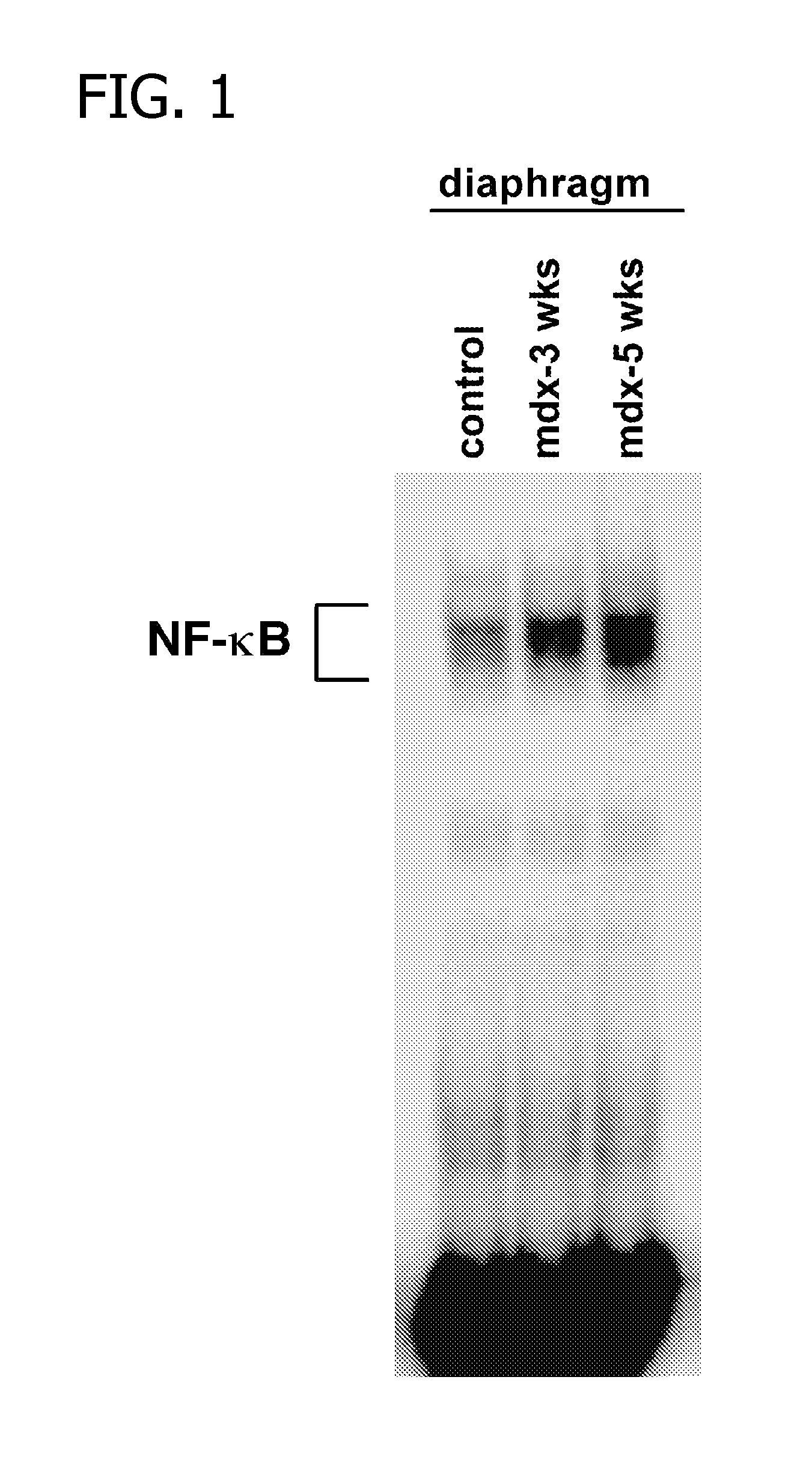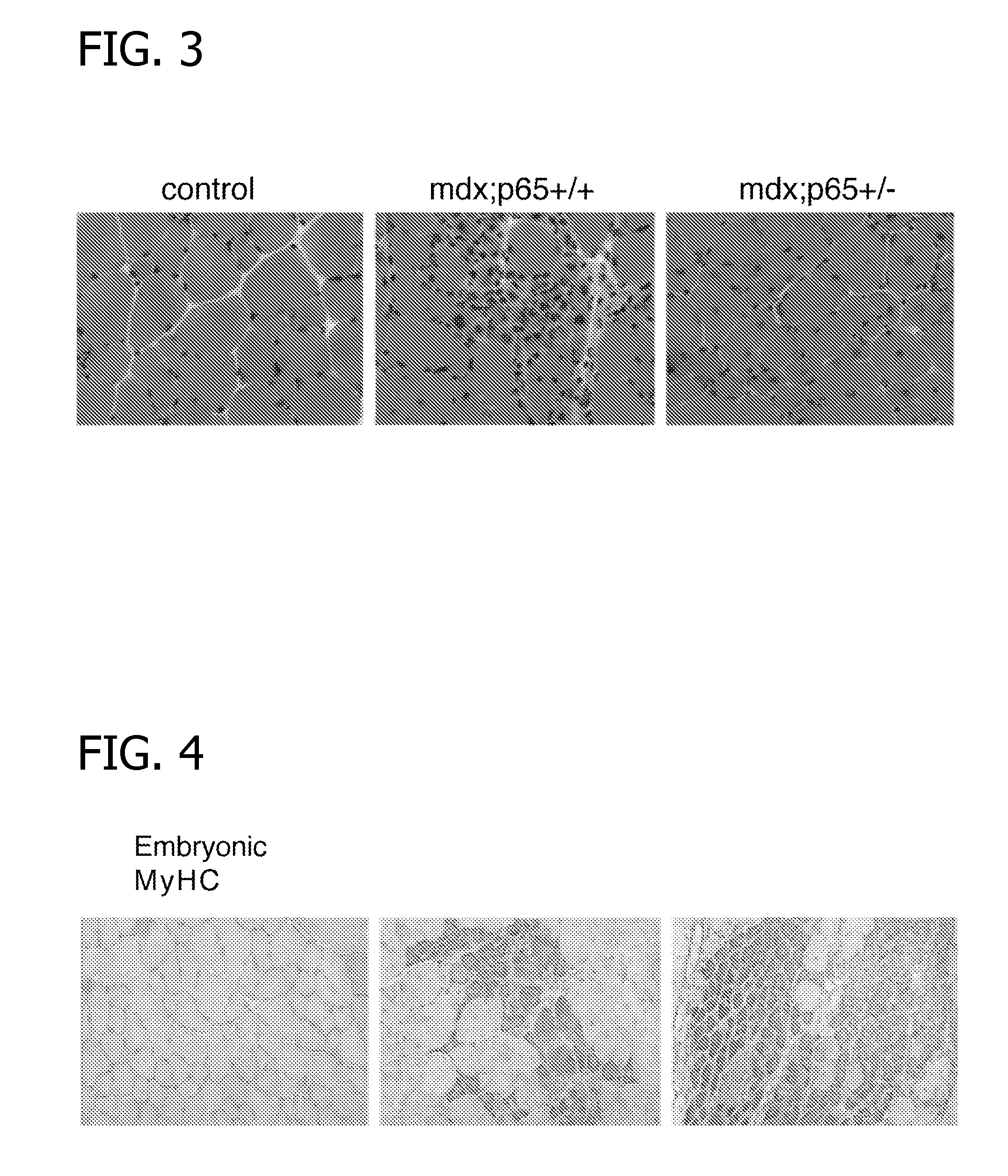Methods of Treating Muscular Wasting Diseases Using NF-kB Activation Inhibitors
a technology of activation inhibitors and muscular wasting diseases, which is applied in the direction of drug compositions, peptide sources, peptide/protein ingredients, etc., can solve the problems of lack of cure, and achieve the effect of inhibiting the muscular wasting diseas
- Summary
- Abstract
- Description
- Claims
- Application Information
AI Technical Summary
Benefits of technology
Problems solved by technology
Method used
Image
Examples
example 1
[0088] In this Example, the DNA binding activity of NF-κB in the skeletal muscles of both healthy control mice and mdx null mice (mdx− / −) was evaluated using electrophoretic mobility shift assay (EMSA).
[0089] The diaphragm muscles from six mdx− / − mice, at an age of three to five weeks old, were removed and nuclear extracts were prepared for use in an EMSA to measure the DNA binding activity of NF-κB.
[0090] The diaphragm muscles of control mice (C57 / BL10) were also removed and nuclear extracts were prepared for use in an EMSA.
[0091] The results of the EMSA for both the mdx− / − mice and control mice were compared and are shown in FIG. 1 below. As shown in FIG. 1, the NF-κB activity of the diaphragm muscles was substantially higher in the mdx− / − mice as compared to the control mice.
[0092] EMSA analysis also revealed that similar reproducible increases in NF-κB activity were observed in mdx− / − tibialis anterior muscles tested using the same method as the diaphragm muscles above. The ...
example 2
[0093] In this Example, mdx− / − mice were crossed with p65 heterozygous mice. The litter was then evaluated to determine if the activation of NF-κB in the mdx− / − mice found in Example 1 above contributes to muscular dystrophy.
[0094] Mdx− / − mice were crossed with p65 heterozygous mice (p65±), and at five weeks old, six litter mates were sacrificed and the tibialis anterior muscles of the litter mates were isolated surgically, frozen for ten seconds at a temperature of about −120° C., and subsequently sectioned for histological analysis. The sections of tibialis anterior muscles were about 10 μm in size.
[0095] The sectioned muscles of healthy control mice, mdx− / − mice, and mice heterozygous for NF-κB (P65±) were analyzed using H&E staining. The results are shown in FIG. 3.
[0096] As shown in FIG. 3, the litter mice that were mdx heterozygous for NF-κB (p65±) had a significant reduction of disease phenotype as compared to the mdx− / − mice alone, as characterized by reduced immune cell ...
example 3
[0099] In this Example, three week old male mdx− / − mice were treated with various peptides comprising NEMO binding domains. The diaphragm muscles of the mice were then evaluated to determine the ability of the peptides to treat muscle wasting in the mdx mice.
[0100] Three week old mdx− / − mice were treated by intraperitoneal injections with 200 pg of either a wild type peptide (SEQ ID NO 19) comprising a NEMO binding domain or a mutant peptide (SEQ ID NO 20). The mice were injected every three days for a total trial period of 27 days. After 27 days, the mice were sacrificed and the diaphragm muscles were removed.
[0101] The diaphragm muscles were placed in a chamber filled with Ringer solution and perfused continuously with an O2 / CO2 mixture. The muscles were then attached using a steel hook to a force transducer and subsequently stimulated at varying frequencies. At each frequency, forces were allowed to reach a steady state before the data was recorded.
[0102] Results of the force ...
PUM
| Property | Measurement | Unit |
|---|---|---|
| Dimensionless property | aaaaa | aaaaa |
| Dimensionless property | aaaaa | aaaaa |
| Catalytic activity | aaaaa | aaaaa |
Abstract
Description
Claims
Application Information
 Login to View More
Login to View More - R&D
- Intellectual Property
- Life Sciences
- Materials
- Tech Scout
- Unparalleled Data Quality
- Higher Quality Content
- 60% Fewer Hallucinations
Browse by: Latest US Patents, China's latest patents, Technical Efficacy Thesaurus, Application Domain, Technology Topic, Popular Technical Reports.
© 2025 PatSnap. All rights reserved.Legal|Privacy policy|Modern Slavery Act Transparency Statement|Sitemap|About US| Contact US: help@patsnap.com



